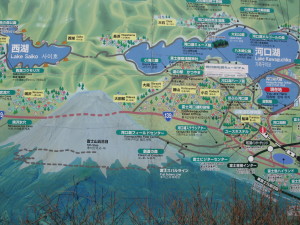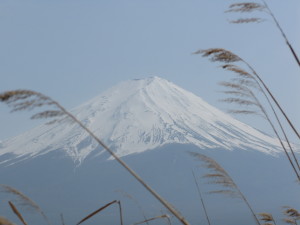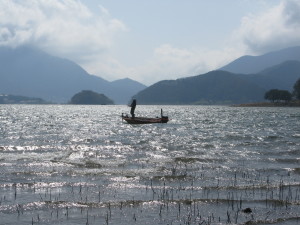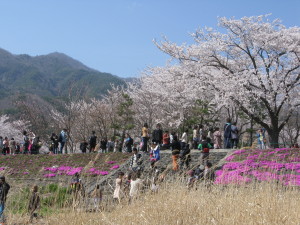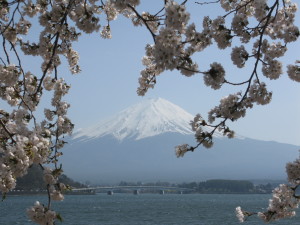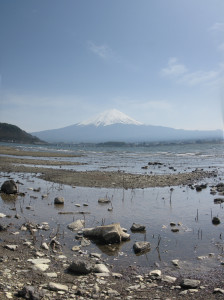Originally we had planned on just admiring Mount Fuji from afar, but it had been too hazy to see it from the Metropolitan Building in Shinjuku, and the weather forecast for Monday was for heavy rain – not conducive to a good view from the train. So we crossed our fingers that Saturday’s promised sunshine would materialise and booked bus tickets to Kawaguchiko in the Five Lakes area. You can get a bus quite a way up Fujisan itself (Fuji 5th Station is a ski resort), but the views are better from further away. Luckily we didn’t leave the decision any later as many of the half-hourly buses were sold out and the seats we got were not together. My knee was still twinging so we indulged in the luxury of a subway ride to Shinjuku station.
The bus company office was very crowded but an employee showed us how to get our tickets from a machine that had only Japanese instructions (enter the phone number that we’d provided when booking online, and feed in some money). It appeared that some tickets were held back for walk-in customers, and then they sold off the seats of people who had booked online but failed to show up, so there was a last minute scrimmage at the counter. Once on the bus we managed to swap seats to sit together for the 2 hour journey.
It took an hour to clear Tokyo then we started to climb into the row of hills that we’d seen from the Metropolitan building. They weren’t very high, but the slopes were steep and thickly wooded – a sprinkling of cherry trees and the rest just coming into new leaf. It was lovely. We finally saw Fujisan only 15 minutes before arriving at Kawaguchiko, where the bus dropped us by the railway station. The sun was shining, as it had been in Tokyo, but it was much, much colder. I was glad I’d brought both a fleece and my pacamac, which helped against the biting wind.
There was a long queue for the oddly named Retro Bus that shuttles people around the 5 Lakes area. In theory they ran to a timetable, but it seemed that they had but on extra buses as there was a constant flow of them. We ended up at the back of a bus so crowded that we stood no chance of getting off it until we were on the other side of Kawaguchi lake. We alighted at a spot marked as a cherry blossom area on our map, and strolled the lakeside with several hundred others taking snaps of Fuji’s perfect snow capped cone across the water.
The blossom season at this altitude was a couple of weeks behind that in the city and the trees were at their peak. It was beautiful, even though Fuji’s lower slopes were hazy and the lake too choppy for reflections – the white peak appeared to just float above the lakeside town. It was even colder here with the wind whipping across the lake, but we pulled up our hoods and set out to walk slowly back along the shore and over the long bridge towards the town. Here it was more sheltered and we found a lakeside park in which to sit and eat our sandwiches.
By now it was around 3:30pm and we’d walked a long way, so we thought we’d catch the Retro bus back to the station, but after 2 crammed buses passed us without stopping we realised we were going to have to walk – luckily we still had time, since our bus tickets were only valid for a specific departure. The journey back was tedious – there was so much traffic on the road down from the mountains that we crawled the whole way and, as the sun set not long after we left Kawaguchiko, the scenery was invisible. But it had been worth the journey – Fujisan is just the most beautiful mountain imaginable, and I understand why it has long been considered sacred. But according to many geologists it’s showing signs of erupting in the near future – sadly, its perfect cone might not be perfect for too much longer.


